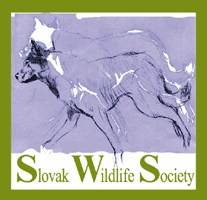

Scientific research
Non-invasive genetic sampling
In 2005-06 the Slovak Wildlife Society participated in what we believe is the first study of bears in Slovakia to be completed using  so-called "non-invasive" methods to obtain samples for genetic analysis. Non-invasive methods, typically the collection of hair and faeces, have several advantages over other methods (e.g. taking samples from shot animals), including the ability to collect samples without disturbing the animals and the possibility of including a greater number and variety of individuals. The study, authored by Milan Paunovic of the Belgrade Natural History Museum and DuÜko Cirovic of the University of Belgrade, came about because Slovak authorities had offered to supply 4 brown bear individuals to help augment the small bear population in Serbia. The Serbian scientists were given the task of performing a feasibility study, the aims of which included determining whether bears from Slovakia would be suitable for this purpose. The Slovak Wildlife Society supplied samples of bear hair and faeces collected from localities in Tatry National Park and NÝzke Tatry National Park during activities forming part of The BEARS Project.
so-called "non-invasive" methods to obtain samples for genetic analysis. Non-invasive methods, typically the collection of hair and faeces, have several advantages over other methods (e.g. taking samples from shot animals), including the ability to collect samples without disturbing the animals and the possibility of including a greater number and variety of individuals. The study, authored by Milan Paunovic of the Belgrade Natural History Museum and DuÜko Cirovic of the University of Belgrade, came about because Slovak authorities had offered to supply 4 brown bear individuals to help augment the small bear population in Serbia. The Serbian scientists were given the task of performing a feasibility study, the aims of which included determining whether bears from Slovakia would be suitable for this purpose. The Slovak Wildlife Society supplied samples of bear hair and faeces collected from localities in Tatry National Park and NÝzke Tatry National Park during activities forming part of The BEARS Project.
Working in collaboration with Professor Etore Randi at his PCR laboratory at the National Institute for Wild Fauna in Bologna , Italy, Serbian scientists succeeded to extract mitochondrial DNA from 5 out of 7 (70%) of the hair samples from Slovakia. All of them had the same haplotype (SLOV88), which was different from the corresponding haplotype of all the analysed samples from Serbia. The results confirm that brown bears in Slovakia belong to the eastern European lineage which also includes bears in Romania, Russia and Estonia. They are therefore unsuitable for release in Serbia, because bears there belong to the completely different, western European lineage. It has been estimated that the western and eastern lineages have been separated for tens if not hundreds of thousands of years. Artificially mixing them, for example by introducing members of the Carpathian population to Serbia, would result in loss of the genetic fund of the native population. The researchers published their findings in 2006 in a report entitled, "Viability increase and recovery of Brown Bear Ursus arctos L. 1758 population in northeastern Serbia".
, Italy, Serbian scientists succeeded to extract mitochondrial DNA from 5 out of 7 (70%) of the hair samples from Slovakia. All of them had the same haplotype (SLOV88), which was different from the corresponding haplotype of all the analysed samples from Serbia. The results confirm that brown bears in Slovakia belong to the eastern European lineage which also includes bears in Romania, Russia and Estonia. They are therefore unsuitable for release in Serbia, because bears there belong to the completely different, western European lineage. It has been estimated that the western and eastern lineages have been separated for tens if not hundreds of thousands of years. Artificially mixing them, for example by introducing members of the Carpathian population to Serbia, would result in loss of the genetic fund of the native population. The researchers published their findings in 2006 in a report entitled, "Viability increase and recovery of Brown Bear Ursus arctos L. 1758 population in northeastern Serbia".
The researchers published their results in 2006 in the report "Viability increase and recovery of Brown Bear Ursus arctos L. 1758 population in northeastern Serbia".



